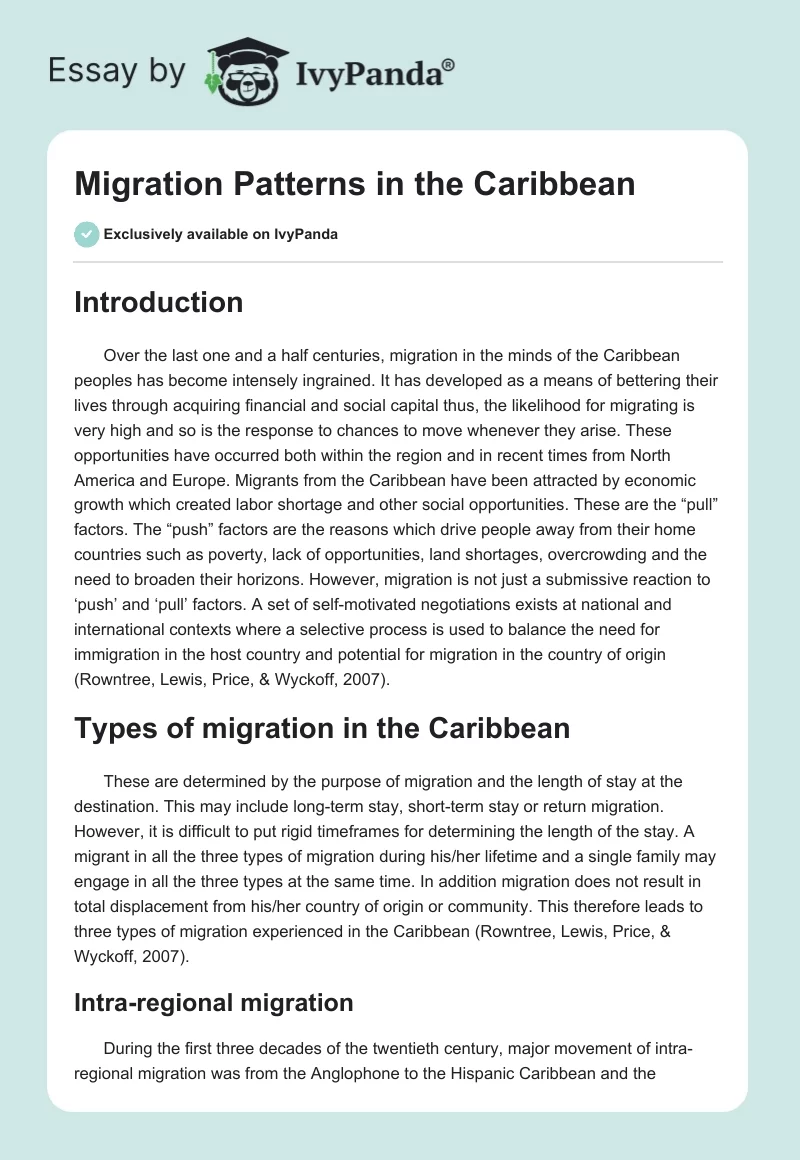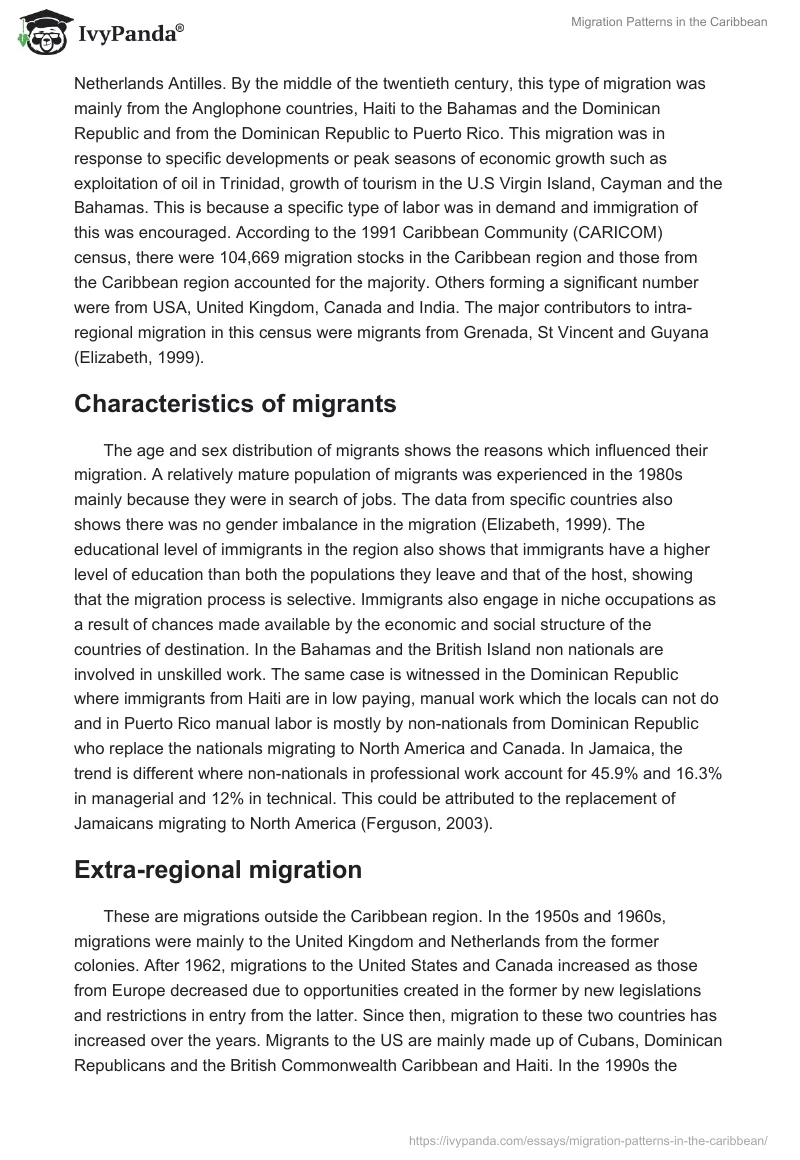Introduction
Over the last one and a half centuries, migration in the minds of the Caribbean peoples has become intensely ingrained. It has developed as a means of bettering their lives through acquiring financial and social capital thus, the likelihood for migrating is very high and so is the response to chances to move whenever they arise. These opportunities have occurred both within the region and in recent times from North America and Europe.
Migrants from the Caribbean have been attracted by economic growth which created labor shortages and other social opportunities. These are the “pull” factors. The “push” factors are the reasons which drive people away from their home countries such as poverty, lack of opportunities, land shortages, overcrowding, and the need to broaden their horizons. However, migration is not just a submissive reaction to ‘push’ and ‘pull’ factors. A set of self-motivated negotiations exists at national and international contexts where a selective process is used to balance the need for immigration in the host country and the potential for migration in the country of origin (Rowntree, Lewis, Price, & Wyckoff, 2007).
Types of Migration in the Caribbean
These are determined by the purpose of migration and the length of stay at the destination. This may include long-term stay, short-term stay or return migration. However, it is difficult to put rigid timeframes for determining the length of the stay. A migrant in all the three types of migration during his/her lifetime and a single family may engage in all the three types at the same time. In addition, migration does not result in total displacement from his/her country of origin or community. This therefore leads to three types of migration experienced in the Caribbean (Rowntree, Lewis, Price, & Wyckoff, 2007).
Intra-Regional Migration
During the first three decades of the twentieth century, major movement of intra-regional migration was from the Anglophone to the Hispanic Caribbean and the Netherlands Antilles. By the middle of the twentieth century, this type of migration was mainly from the Anglophone countries, Haiti to the Bahamas and the Dominican Republic, and from the Dominican Republic to Puerto Rico. This migration was in response to specific developments or peak seasons of economic growth such as exploitation of oil in Trinidad, growth of tourism in the U.S Virgin Islands, Cayman, and the Bahamas. This is because a specific type of labor was in demand and immigration of this was encouraged.
According to the 1991 Caribbean Community (CARICOM) census, there were 104,669 migration stocks in the Caribbean region, and those from the Caribbean region accounted for the majority. Others forming a significant number were from the USA, United Kingdom, Canada, and India. The major contributors to intra-regional migration in this census were migrants from Grenada, St Vincent, and Guyana (Elizabeth, 1999).
Characteristics of Migrants
The age and sex distribution of migrants show the reasons which influenced their migration. A relatively mature population of migrants was experienced in the 1980s mainly because they were in search of jobs. The data from specific countries also shows there was no gender imbalance in the migration (Elizabeth, 1999). The educational level of immigrants in the region also shows that immigrants have a higher level of education than both the populations they leave and that of the host, showing that the migration process is selective. Immigrants also engage in niche occupations as a result of chances made available by the economic and social structure of the countries of destination.
In the Bahamas and the British Islands non-nationals are involved in unskilled work. The same case is witnessed in the Dominican Republic where immigrants from Haiti are in low-paying, manual work which the locals can not do, and in Puerto Rico manual labor is mostly by non-nationals from Dominican Republic who replace the nationals migrating to North America and Canada. In Jamaica, the trend is different where non-nationals in professional work account for 45.9% and 16.3% in managerial, and 12% in technical. This could be attributed to the replacement of Jamaicans migrating to North America (Ferguson, 2003).
Extra-Regional Migration
These are migrations outside the Caribbean region. In the 1950s and 1960s, migrations were mainly to the United Kingdom and Netherlands from the former colonies. After 1962, migrations to the United States and Canada increased as those from Europe decreased due to opportunities created in the former by new legislations and restrictions in entry from the latter. Since then, migration to these two countries has increased over the years. Migrants to the US are mainly made up of Cubans, Dominican Republicans, and the British Commonwealth Caribbean and Haiti. In the 1990s the stream from these countries has increased dramatically, especially from the Dominican Republic and Jamaica. Immigrants from other small countries such as Trinidad and Tobago, Barbados are very significant in comparison to the small population sizes in their own countries. The US has also implemented refugee movement and guest worker programs in addition to regular visas which have seen migrants stay for long durations for work or education or both (Ferguson, 2003).
Return Migration
This describes the movement of the people to their countries of origin for periodic or regular visits before they settle indefinitely. Even after settling indefinitely, they continue to visit their former residents for varying durations of time. This also involves remittances either in financial capital or goods to their Caribbean countries of origin. This can be through formal or informal means either before, along with or following their return to their countries. Those with intention of returning may remit savings to invest in their own countries or others which they deem safer to invest in or maybe recipients of pensions or social security payments for the rest of their lives and choose to return home. In Jamaica for example the personal transfers of the period between 1991 and 1997 were more than the foreign currency earned in other sectors and in Barbados transfers from Britain of pension payments in 1997 were approximately 6 million pounds sterling (Elizabeth, 1999).
Conclusion
Migration in the Caribbean region has a long history and has tended to follow “push” and “pull” factors. However, in recent history, selective processes which have encouraged migration to some countries and discouraged movement to others have been put in place. This has given rise to three types of migration patterns. Intra-region migration involves movement within the Caribbean region. Extra-regional migration has seen Caribbean people move to other countries of the world mainly in the UK and Netherlands first and then to the US and Canada. Return migration involves the movement of Caribbean people in foreign countries to their countries of origin either to stay indefinitely or for a duration of time. This has also seen the remittance of goods and financial capital to the Caribbean countries either as investments or pensions or other retirement benefits.
Reference List
Elizabeth T. H. (1999). Trends and Patterns of Migration to and from Caribbean Countries. Goggles Docs. Web.
Ferguson, James. (2003). Migration in the Caribbean: Haiti, the Dominican Republic and Beyond. Minority Rights Group International. Goggles Docs. Web.
Rowntree, L., Lewis, M., Price, M., and Wyckoff, W. (2007). Globalization and Diversity, Geography of a Changing World. Pearson Education.


